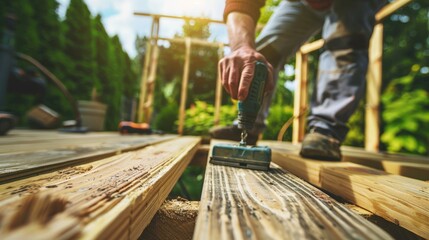When assessing the cost of deck repair, it’s important to prioritize long-term safety fixes that can eliminate ongoing issues and prevent costly future repairs. This may include addressing structural problems such as rotting boards or weak railings.

Inspect deck boards for splinters and test them for moisture damage by tapping them gently with a screwdriver. Any areas that sound soft or spongy indicate rot and need to be replaced. Contact Deck Builders Baltimore County for professional help.
Over time, your deck will become worn down by weather and foot traffic. This can lead to cracks and tripping hazards. While some of these problems are relatively easy to repair, others require a more thorough inspection. For example, extensive cracking may indicate that the deck boards need to be replaced. If not addressed, these issues can worsen and lead to a collapsed deck.
Structural problems are among the most serious and dangerous issues that can occur with a deck. They can affect the safety of everyone who uses it, as well as the integrity of the entire structure. Signs of structural deterioration include sagging or wobbling, and loose railings. These problems can be caused by improper initial construction or damage to critical components like posts and joists.
If left untreated, rot can spread quickly and cause severe damage to your deck. The best way to avoid rot is to treat your deck regularly with wood preservatives. In addition, it is important to make sure that your deck is well-ventilated. If moisture is allowed to build up under your deck, it can cause mold and mildew growth and rotting of the structural supports.
Another common mistake that homeowners often make is using low-grade materials when repairing or building their decks. These materials are usually cheaper, but they can also deteriorate more quickly and lead to more expensive repairs in the long run. A professional can help you select high-quality materials that are suited for the climate and usage patterns in your area. They can also help you follow local building codes and regulations to ensure that your deck is safe and legal to use.
If you have noticed any of these issues, it is important to seek out professional help as soon as possible. A knowledgeable professional can help you determine whether a deck repair or replacement is required and recommend the right solution. They can also advise you on how to maintain your deck and prolong its lifespan. In most cases, a professional will be able to provide a cost-effective solution that is both durable and safe for your family.
Cosmetic Issues
Typically, cosmetic issues are addressed with re-painting and re-staining. The most important thing to remember about cosmetic issues is that they should be addressed promptly to prevent larger problems from developing. A reputable contractor can help you make these repairs quickly and efficiently so that your deck remains in good shape for years to come.
Inspect the surface of your deck for signs that it is in need of repair. Look for stains, cracks, and warping. In some cases, these problems can be fixed with sanding and wood filler. However, excessive splintering or significant damage may indicate a need for a full replacement of the deck.
Also, examine the deck’s substructure for structural problems. Look for loose boards, rotted or weakened posts, and missing joists or beams. If the joists or beams are rotting, consider using Trex Protect joist tape to protect them from further damage and prevent a potential safety hazard for your family and guests.
Look for rusty nails or screws that need to be replaced, especially in areas that are exposed to moisture. These metal fasteners can rust and compromise the integrity of the deck.
Lastly, check your railings and stairs for stability. Loose or wobbly railings can pose a serious safety hazard for your family and guests, so it’s best to fix these problems immediately. Unstable stairs can be caused by rotting wood, pest damage, or incorrect construction. Tightening loose railings, repairing or replacing damaged balusters and rungs, and adding additional supports can make these areas safe again.
A sagging section of the deck or unstable railings can indicate that the deck is no longer structurally sound and requires a replacement. Stairs with uneven steps can be a trip or fall hazard for your family and guests, and can also cause injury if someone falls.
It’s best to have a professional evaluate your deck after a haul-out or when you suspect damage to determine the extent of the problem and what the best solution might be. A qualified inspector will be able to identify hidden problems like underlying moisture and core issues that may need to be treated with preservatives or replacement to prevent structural failure.
Cost
Many factors affect the cost of repairing or replacing your deck. The type of deck and materials used are important considerations, as are any elements such as railings, stairs, or furniture that may need to be replaced. The season in which repairs are conducted can also impact costs, as the demand for contractors can be higher during peak seasons. In addition, repairs that require specialized or hard-to-find materials can increase the overall cost of the project.
Repairing or replacing your deck can be an expensive endeavor, but it’s often worth the investment to keep your outdoor space in good condition and safe for family and guests. Some issues, such as loose boards or rotting wood, can be addressed with simple repair techniques, while others are more serious and warrant a replacement.
If you’re unsure whether to pursue repair or replace, it’s a good idea to consult with a professional. A deck builder or contractor can inspect your existing deck for any structural problems and determine the best course of action. They can also help you budget for the project and recommend the best materials to use.
Some repairs are relatively straightforward and can be completed by a home owner with some DIY experience. For example, popped nails or screws are usually a quick fix that involves hammering them back in place. However, if the problem is more significant, you’ll need to hire a professional to ensure that the work is done correctly and safely.
Other common issues that necessitate hiring a professional include wood rot and termite infestation. Moisture accumulation and poor drainage can lead to rot and sagging, while termites silently consume the wood from the inside out. Both of these problems can be costly to repair, so regular inspections and preventive measures are essential to preventing them.
Another factor to consider when deciding between repair and replacement is the amount of time that you’re willing to spend on maintenance. If your deck is in disrepair, and you anticipate safety concerns resurfacing within a year or so, it might be more cost-effective to invest in a replacement.
Time
A well-maintained deck is a wonderful place to spend time with family and friends. But, it can also become dangerous if structural issues occur. Identifying these problems and taking the necessary steps to repair them will ensure that your deck is safe for all of those who use it.
Structural damage is often noticeable by significant splintering, cracking, warping, and loose boards. In addition, rotting and rusty fasteners can compromise the deck’s integrity. It is important to inspect the entire deck, paying special attention to areas that are in direct contact with the ground, such as stair stringers and joists. Checking for rot is easy – simply sink the tip of a screwdriver into a board or post and see if it goes in easily. If it does, the deck is likely in need of major renovation.
Cosmetic issues can be harder to detect but are still important to address. In general, it is recommended that you sand and scrape the old deck before applying any new stain or paint. This will help remove any dirt or mildew, which can cause the new finish to fail. It is important to wear work gloves and safety goggles during this process to avoid splinters.
Once the wood is sanded, it is essential to test for moisture and rot. To do this, pour a capful of water onto different surface areas of the deck. Inspect the area for any spots that absorb the water quickly, such as shady or sunny spots and new or old boards. Any areas that are beading water require additional attention to moisture and rot prevention.
When deciding to repair or replace your deck, it is important to understand the costs involved. The cost of a new deck is dependent on the material used, its size, and the design of the deck. Some materials are more expensive than others but are long-lasting and durable.
Depending on the age of your deck and the severity of the damage, it may be worth investing in a replacement instead of repairing it. A new deck can be a great way to add value to your home and improve its appearance. However, it is important to understand that a deck’s condition is not just about its boards; the railing, stairs, and the underlying structure may need replacing as well.

